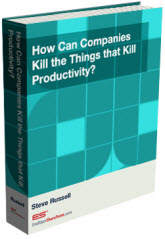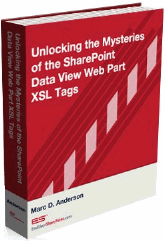On Babies, Bathwater, and SharePoint Designer
 On April 2nd, as has been rumored for quite some time, Microsoft announced that SharePoint Designer is available as a free download. (Get it Here…)
On April 2nd, as has been rumored for quite some time, Microsoft announced that SharePoint Designer is available as a free download. (Get it Here…)
Reaction to even the rumors of this has ranged from very positive, to downright horrified. So, what’s all the fuss about? What is SharePoint Designer, and why should you care?
Just What is SharePoint Designer Anyway?
SharePoint Designer, at its core, is a web design and editing tool. Think of it as a word processor for Web pages. It gives users a roughly "what you see is what you get" (WYSIWYG) view of their web page as they build it.

This makes it very easy to create and edit web pages. But, because web sites can be much more complicated that Word documents, there are also a lot of options that allow the user to manage different bits and pieces of the site beyond the current page. Even if SharePoint Designer did nothing else, that would make it a very powerful tool for creating and editing web sites of all kinds.
Shameless Plug: You can get a nice overview of the basic Web-design features of SharePoint Designer from the freely-downloadable chapter 1 of my book. You can also read the Introduction to the book on this site, or at EndUserSharePoint.com. (Buy the whole book here.)
But Wait! There’s More…
What makes SharePoint Designer different from virtually all other web design tools is that it is fully aware of SharePoint and its functionality – such as lists, libraries, and master pages – as well. In addition, SharePoint Designer gives you easy access to many powerful SharePoint features, such as the ability to integrate with external data sources Data View/Form Web Parts, that are not readily available in any other way.
Now How Much Would You Pay? ;)
The Price of Freedom
"The price of freedom is eternal vigilance." – Thomas Jefferson, US Founding Father.
"With Mogwai comes much responsibility." – "Grandfather", in the movie Gremlins.
When this version of SharePoint (WSS 3.0 and MOSS 2007) first came out, SharePoint Designer was released for sale for several hundred dollars. And it was well worth it! It is an extremely powerful and versatile tool. By making it available as a free download, Microsoft is bringing that power and versatility to a whole new audience.
This is certainly cause for celebration!
Yet it is that very availability which is also causing the horror mentioned at the start of this article. In untrained hands, and/or without proper safeguards, a power tool like SharePoint Designer can also cause a great deal of damage. So how do you, as a corporate IT person, manage the risks involved?
Fortunately, there are many ways to control the use of SharePoint Designer within an organization. The SharePoint Designer team at Microsoft has published a great article on the various control mechanisms available, and I also talk about them in my book. I’ll just refer you there for the "how to". However, I do want to discuss a bit of the "why" side, or in some cases, the why not to, of implementing these controls.
First the "Not".
The control options described in the Microsoft article include hard-coding changes to SharePoint site definitions to block the use of SharePoint Designer on sites based on them. I believe that such a tactic is a knee-jerk reaction, overkill, and amounts to "throwing the baby out with the bathwater".
Blocking editors at the site definition level is asking for trouble on a number of different levels. Beyond the general cautions about making changes to site definitions (which are beyond the scope of this article), you need to be aware that this change impacts all users, forever. Even if you later decide that specially trained users should be allowed to make customizations with SharePoint Designer or its successors, they won’t be able to. Just don’t do it!!
The Right Way
Many enterprises use group policy to control what applications can be installed on users’ desktops, and even what features are available. If your organization already controls software installation, this is a great first step. You can use these policies to decide just who can install and use SharePoint Designer.
On the SharePoint site itself, there are also many controls. The first line of defense here is, don’t give administrator or web designer rights to users who don’t need them. The default "member" or "contributor" roles available in SharePoint provide all of the access most users need. They allow users retrieve information through browsing and search, as well as add and edit documents or list items. Naturally, site owners will have administrative rights to their areas, and can further delegate enhanced rights to their users, but they can’t override your group policies.
So, between those two configurations, you will have nipped in the bud virtually any casual hazard that "free" access to SharePoint Designer may present. These also represent general enterprise networking "best practices".
Finally, like any powerful tool, you should make sure that users are trained in SharePoint Designer’s use before turning them loose. These users should understand not only SharePoint Designer itself, but the capabilities of SharePoint they are planning to modify. I have taken that into account in my book (which includes chapters on understanding SharePoint, as well as SharePoint Designer), and there are several other excellent resources available.
In Conclusion – The Sky is Not Falling
SharePoint Designer is a powerful tool, and Microsoft has just brought it to the masses by making it available as a free download. While caution on the part of IT managers is justified, there is a place for SharePoint Designer in the enterprise. Like any powerful tool, it is important to understand what SharePoint Designer is, and its true impacts on your systems. Users should be trained in its proper use before allowing it to be deployed. However, you do not need to "throw the baby out with the bathwater" by permanently blocking it from your organization.
 Author: Woody Windischman
Author: Woody Windischman
Site: The Sanity Point
Woody Windischman is a technology consultant with over 20 years of experience in a variety of roles, providing a unique perspective which allows him to see problems holistically.
Since getting acquainted with Microsoft IIS and FrontPage in the mid 90’s, Woody has been deeply involved in the community – first having been awarded as a Microsoft SharePoint MVP from October 2005 through September of 2007, and then spending a year working directly with the SharePoint product team.
 Professional Microsoft Office SharePoint Designer 2007
Professional Microsoft Office SharePoint Designer 2007
Woodrow W. Windischman, Bryan Phillips, Asif Rehmani
ISBN: 978-0-470-28761-3
- Page Sizes and Browser Preview in SharePoint Designer
- Press F1 - SharePoint Help is on the Way
- Book Excerpt: Introduction to "Professional SharePoint Designer 2007"
- On Babies, Bathwater, and SharePoint Designer
- Wiki-in-the-Box - Is SharePoint Wiki Really that Bad?
- A Hidden Gem - the Preview Pane View in SharePoint
- The Office 2010 Synchronization Center
- Binary Free SharePoint Twitter Search Web Part
- SharePoint 2010 - Everything Old is New Again
- SharePoint: On Ends and Means











